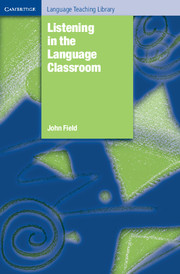Book contents
- Frontmatter
- Contents
- Dedication
- Acknowledgements
- Introduction
- Part I Background
- Part II Rethinking the comprehension approach
- Part III Process, not product
- Part IV A process view of listening
- Part V The challenge of the real world
- Part VI Conclusion
- Appendices
- Glossary of listening-related terms
- References
- Index
Introduction
Published online by Cambridge University Press: 01 October 2009
- Frontmatter
- Contents
- Dedication
- Acknowledgements
- Introduction
- Part I Background
- Part II Rethinking the comprehension approach
- Part III Process, not product
- Part IV A process view of listening
- Part V The challenge of the real world
- Part VI Conclusion
- Appendices
- Glossary of listening-related terms
- References
- Index
Summary
The word is half his that speaks and half his that hears it.
Michel de Montaigne (1533–1592), French essayistWhy teach listening?
Why teach listening? seems an odd question. It is standard practice nowadays for language teachers to provide sessions that focus on this particular skill. There is a wide choice of listening materials available with accompanying CDs, and DVD or video is used in many classrooms.
Nevertheless, there is still plenty of evidence that listening is undervalued. When there is pressure on contact hours, it is often the listening session that is cut. Students are rarely assessed on their listening skills, and the problems of many weak listeners pass undiagnosed. The methodology of the listening lesson has been little discussed, researched or challenged; and there is a tendency for teachers to work through well-worn routines without entire conviction. Alternatively, a faddish commitment to an ‘integrated skills’ approach may result in listening being relegated to a hasty topic-driven session wedged between reading and writing, which tend to be regarded as more manageable skills.
Listening on the back burner
The reasons for this lack of priority are partly historical. There was a time when listening in the language classroom was almost entirely subordinated to the presentation of new items of language. Short dialogues on tape provided examples of structures to be learned (see, for example, Alexander, 1967), and this was the only type of listening practice that most learners received.
- Type
- Chapter
- Information
- Listening in the Language Classroom , pp. 1 - 10Publisher: Cambridge University PressPrint publication year: 2009
- 2
- Cited by

